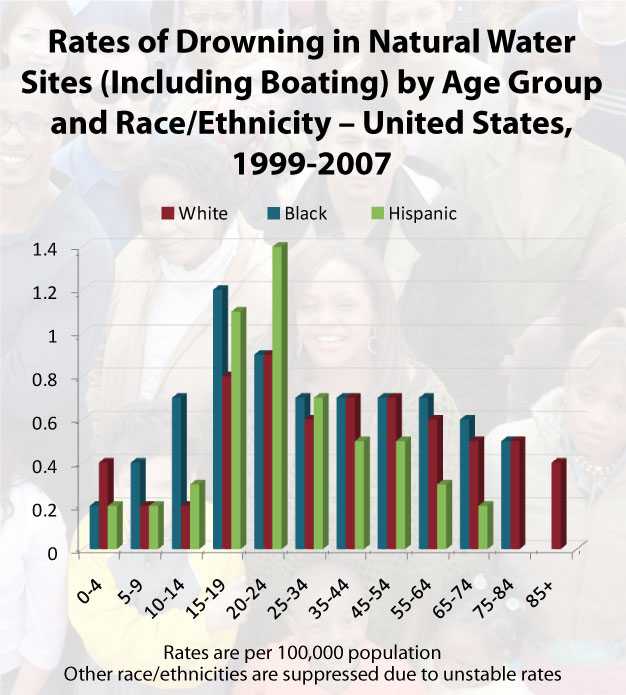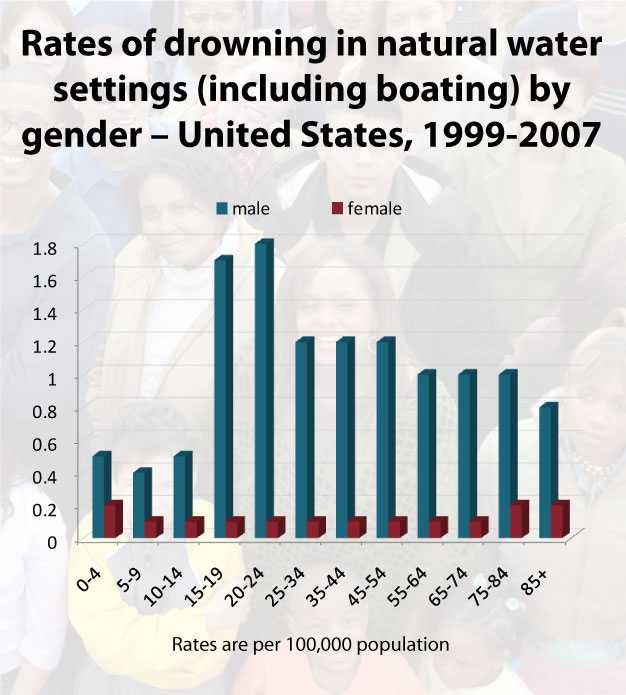Drowning Risks in Natural Water Settings
Drowning is the second leading cause of unintentional injury death for children ages 1 to 14 years, and the fifth leading cause for people of all ages. Learn how to reduce your risk.
 There's nothing better than a day at the beach or on the lake. But swimming in a natural body of water, or enjoying the day on a boat can be risky. About half of all drownings occur in natural water settings such as lakes, rivers, or oceans. The risk of drowning is also higher among some population groups (e.g., age groups, race or ethnicities, gender). But there are ways to be safe, whether you're at the lake, the beach, or on a boat.
There's nothing better than a day at the beach or on the lake. But swimming in a natural body of water, or enjoying the day on a boat can be risky. About half of all drownings occur in natural water settings such as lakes, rivers, or oceans. The risk of drowning is also higher among some population groups (e.g., age groups, race or ethnicities, gender). But there are ways to be safe, whether you're at the lake, the beach, or on a boat.
Settings
In 2007, at least 43% of all recreational water drownings occurred in natural water settings. Another 9% of drownings occurred in boating incidents, for a total of 52%. This is almost three times the number of drownings occurring in swimming pools in the same year (19%).1
Age and Race/Ethnicity
Among Blacks, drowning rates increase through childhood and peak at 15 to 19 years of age. Drowning rates among Whites are higher than Blacks and Hispanics between ages zero and 4 years of age, and then decrease from 5 to 14, and peak between ages 15 to 24 years. Among Hispanics, drowning rates increase substantially at 15 to 19 years, and peak between the ages of 20 and 24 years.
Age and Sex
The highest risk of drowning for both males and females is between ages 1 to 4. The risk of drowning decreases for both sexes from ages 5 to 14, then increases substantially at age 15 and remains elevated throughout adulthood.1
As infants, males and females have similar risk of drowning in natural water settings. After the age of one, however, males are at a substantially increased risk of drowning, accounting for 88% of all drownings in natural water settings, including while boating.1
Boating Risks
According to the United States Coast Guard, almost 75% of all persons killed in boating incidents in 2007 drowned. Of those, 84% were not wearing a life jacket.2 Operator error, lack of training, and alcohol use contribute to the risk of drowning in a boating incident. Twenty-nine percent of deaths occurred on boats that were anchored, docked, moored or drifting.2
Rip Currents
Rip currents are powerful, narrow channels of water moving in the offshore direction. They can occur along any coastline with breaking waves, but are prevalent along most U.S. coastlines. A rip current pulls swimmers away from the shore into deeper water at speeds of up to 8 feet per second – faster than an Olympic swimmer. They can sweep even the strongest swimmer out to sea, and thus are dangerous to all swimmers.3
- Rip currents account for over 80% of rescues performed by surf beach lifeguards.4
- The United States Lifesaving Association estimates that more than 100 people die each year due to rip currents on our nation's beaches.4
Safety Tips for Swimmers and Boaters
Whether it's an uneven lake bottom or drop-off, rip current or unexpected hazardous weather, swimmers in natural water settings need to be aware of the dangers and take special precautions to stay safe. Here are a few safety tips:
- Learn to swim. Formal swimming lessons can protect young children from drowning. However, even when children have had formal swimming lessons, constant, careful supervision is necessary when children are in or around the water.
- Watch swimmers in or around the water. Designate a responsible adult who can swim and knows CPR to watch swimmers in or around water. The supervisor should not be involved in any other distracting activity (such as reading, or talking on the phone) while watching children.
- Learn Cardiopulmonary Resuscitation (CPR). In the time it might take for lifeguards or paramedics to arrive, your CPR skills could make a difference in someone's life.
- Use Buddy Systems and Lifeguards. Regardless of your age, always swim with a buddy. And select swimming sites that have lifeguards whenever possible.
- Heed warning flags. Know the meaning of and obey warnings represented by colored beach flags [PDF – 201KB], which may vary from one beach to another.
- Know the terrain. Be aware of and avoid drop-offs and hidden obstacles in natural water sites. Always enter water feet first.
- Avoid rip currents. Watch for dangerous waves and signs of rip currents (e.g., water that is discolored and choppy, foamy, or filled with debris and moving in a channel away from shore). If you are caught in a rip current, swim parallel to shore; once free of the current, swim toward shore.
- Use life jackets. Use U.S. Coast Guard-approved life jackets when boating, regardless of distance to be traveled, size of boat, or swimming ability of boaters. Do not use air-filled or foam toys, such as "water wings", "noodles", or inner-tubes, in place of life jackets (personal flotation devices). These toys are not designed to keep swimmers safe.
- Avoid alcohol. Avoid drinking alcohol before or during swimming, boating, or water skiing. When boating, safety risks from alcohol use are increased whether boat operator or passenger. Do not drink alcohol while supervising children.
- Learn boating safety. Take a boating safety course.
- Know the weather. Know the local conditions and forecast before swimming or boating. Strong winds and thunderstorms with lightning strikes are dangerous.


References
- Centers for Disease Control and Prevention, National Center for Injury Prevention and Control. Web-based Injury Statistics Query and Reporting System (WISQARS) [online]. [cited 2011 May 26]. Available from: URL: https://www.cdc.gov/injury/wisqars
- U.S. Coast Guard, Department of Homeland Security (US). Recreational Boating Statistics – 2009 [online]. [cited 2011 May 26]. Available from http://www.uscgboating.org/assets/1/workflow_staging/Publications/394.PDF [PDF – 5.10MB]
- http://www.ripcurrents.noaa.gov/overview.shtml
- www.usla.org
More Information
The following resources offer information that can help you stay safe on the water:
CDC Resources
- Facts and Resources about Water-related Injuries
- Protect the Ones You Love: Drownings Fact Sheet
- Healthy Swimming and Recreational Water Facts
Download or listen to a podcast
- Protect the Ones You Love from Drowning [PODCAST – 3:05 minutes] (2008)
- Staying Safe in the Water [PODCAST – 5:38 minutes] (2008)
- Staying Safe on the Water [PODCAST – 3:45 minutes] (2008)
External Resources
- National Safe Boating Council
- North American Safe Boating Campaign
- U.S. Coast Guard Office of Boating Safety
CDC works 24/7 saving lives and protecting people from health threats to have a more secure nation. A US federal agency, CDC helps make the healthy choice the easy choice by putting science and prevention into action. CDC works to help people live longer, healthier and more productive lives.
- Page last reviewed: June 13, 2012
- Page last updated: June 13, 2012
- Content source:
- National Center for Injury Prevention and Control
- Page maintained by: Office of the Associate Director for Communication, Digital Media Branch, Division of Public Affairs




 ShareCompartir
ShareCompartir